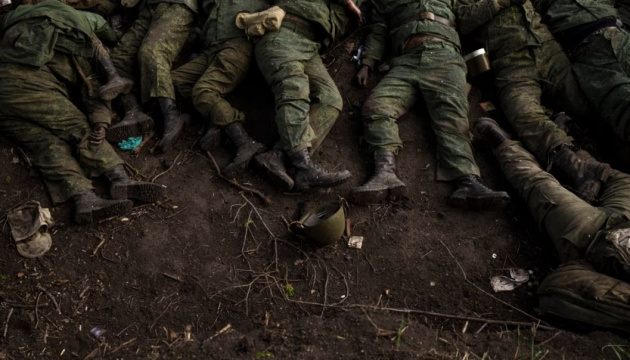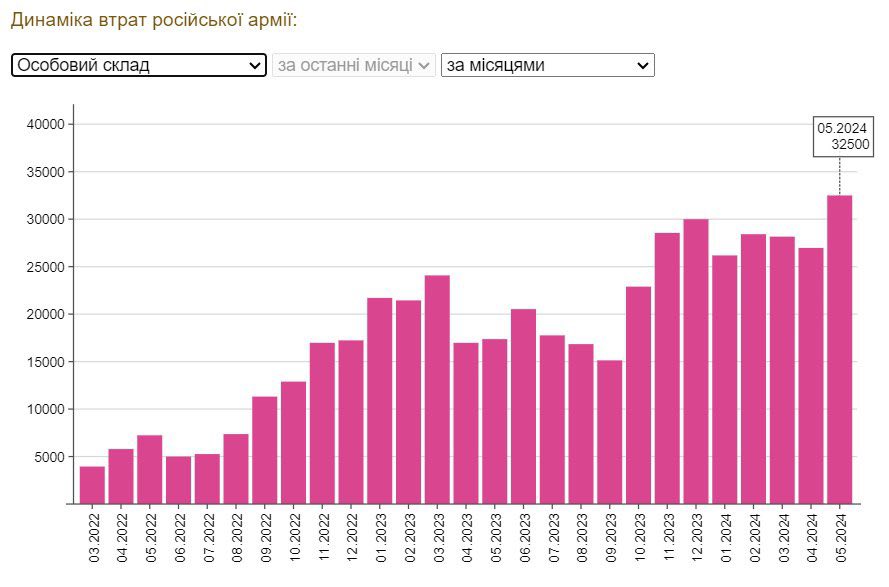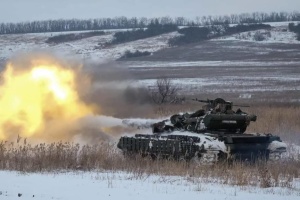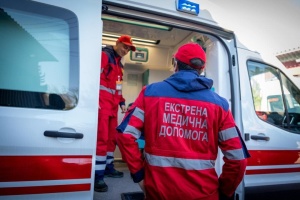
Russia’s war toll has surged past half a million. What does such a high toll amount suggest?
On May 25, 2024, the war had reached a psychologically important milestone: the Ukrainian Armed Forces had got over 500,000 Russian invaders killed or seriously injured. And this is truly a colossal achievement by the Ukrainian military.
Over 500,000 ruscist casualties, killed or seriously wounded, are more than the population of some countries. As of 2024, according to Rosstat, Russia’s statistics agency, there were 36 cities with a population exceeding half a million in Russia, among them Naberezhnye Chelny, Penza, Tula, Lipetsk, Cheboksary, or Kirov... So if you imagine that these half a million fallen Russian soldiers were residing in one of such cities, then it can be said that it no longer exists; just imagine that all of the city has disappeared.
Well, here is one more interesting fact: if we take into account NATO’s data as of October 2022, the Russian Federation had lost almost as many soldiers as there are in the regular (sic!) armies of 20 NATO countries combined. Specifically, we are talking about Greece (111,400 service members), Romania (78,500), Canada (68,200), Bulgaria (27,400 ), the Czech Republic (26,900), Portugal (26,500), Norway (22,600), Belgium (22,500), Hungary (21,400), Denmark (17,200), Lithuania (17,200), Croatia (15,200), Slovakia (13,800), Albania (6,600), North Macedonia (6,200), Slovenia (5,900), Estonia (6,900), Latvia (7,500), Montenegro (1,700), Luxembourg (900), which makes a total of 505,000 service members.
But we are interested in something else - to what extent the published figures are real and whether they can be overestimated.
Information from British and French colleagues will help answer this question. They have not yet published the most recent data as of May 28, but there is data available as of May 3 and 4. At that time, the UK Ministry of Defense estimated Russian combat casualties in the war in Ukraine at more than 465,000 personnel, while the French Ministry of Foreign Affairs gave an approximate figure of 500,000 total Russian casualties, killed and wounded. At the same time, Ukraine’s General Staff reported that Russia’s total combat casualties amounted to 473,000 as of May 4.
As you can see, these estimates differ only marginally, or, as sociologists say, they are within a statistical margin of error.
"The difference in various special services’ estimates of Russian losses in the war the Russian Federation is waging in Ukraine is attributed to different calculation methods used by the analytical units of these or other special services. Usually, these are the calculation algorithms that have been tested in many military conflicts. But each of them are employing algorithms of their own, based, respectively, on different intelligence. However, the fact that different, independent military departments give almost identical figures of losses, proves their objectivity. During the two years of the war in Ukraine, which Russians refer to as “special military operation”, the enemy’s irretrievable losses have hit half a million (!) troops,” Pavlo Lakiychuk, head of military programs at the Center for Global Studies "Strategy XXI", said in a comment to Ukrinform.
Oleksandr Kovalenko, a military analyst at the "Information Resistance" group and Stanislav Bezushko, a military reporter, agree with the given estimates of Russia’s toll of combat casualties from the war. Regarding how far the given amount of 500,000 fatalities is real, we found out: there is a logic behind it, and experts confirm it.
But there is another important question: what do these 500,000 casualties mean actually?
It should be noted that war losses are categorized into two types of losses: irreversible and sanitary losses. Sanitary losses can be severe, meaning a seriously wounded casualty will never be able to return to the army ranks, or they can be light, which means a wounded casualty will be able to fight for a few days after being wounded. According to experts, Ukraine’s Defense Forces publish statistics that includes precisely (!) irretrievable losses.
"The Armed Forces General Staff does not reveal in detail what it means by the term "enemy’s daily losses”. Intelligence agencies of other countries do not explain this either. However, it is clear that we are talking about irreversible losses - killed and seriously wounded, that’s to say, those who will never return to the army ranks. Irretrievable losses include those killed, missing, captured, as well as the injured who died of wounds or received a disability incompatible with further active military service," said Pavlo Lakiychuk.
The analyst also cited interesting figures: according to statistics provided by the Russian Federation’s Pension and Social Insurance Fund, the number of men aged 31 to 59 with disabilities increased by 30%, or by 507,000 persons over the period from 2022 to 2023, while in the previous periods these figures were relatively stable at 6-7% (in 2022 in Russia, there were 1.67 million men with disabilities in this age category).
"It's what's on the surface. That being said, the Russian authorities are trying in every possible way to hide from the public statistics data from which the Russian people could learn about the Kremlin’s “successes” in this war. For some reason, I’m expecting that this statistics will be closed to public access next year. But, I am convinced, the year 2024 will see a "new stability" in the statistics data provided by the Russian Federation’s pension authorities.
"What does the figure of 500,000 mean? It includes not only dead casualties, but also wounded casualties. What kind of the wounded? As far as I know, our General Staff records only irreversible losses. This is one. Second is the classical kill to wounded ratio, which ranges between 1:3 to 1:5. But this indicator is variable. Everything depends on which part of the front line we are talking about, the intensity of combat, the status of troops involved, whether they are on the defensive or on the offensive... For example, if we are talking about a location like Krynky (Kherson region), which is subject to never-ending assaults by Russian forces , the enemy tries evacuating its wounded casualties, and therefore the dead to wounded ratio remains classical at 1:3 or 1:5. At the same time, at the front lines like Bakhmut, Avdiivka, or Chasiv Yar, the Russians do not even evacuate their wounded casualties from the battlefield, leaving them wallowing in the mud, and, by the end of the battle, these wounded casualties move into the category of dead casualties. The term "classical ratio” is no longer applicable to the type of hostilities waged at these front lines. On the contrary, the ratio can be 1:1 or even 1:0, meaning all dead and no wounded. In the end, it is important to understand that even if a wounded invader is able to be evacuated from the battlefield and brought to a hospital, it is far from certain that he will survive. Why? It’s for a number of reasons. This is due, for instance, to a lack of appropriate first-aid kits. Furthermore, a significant number of the enemy's troops simply don’t know how to do first aid until help arrives. Regarding the Ukrainian military, the situation with this all is way better, says Oleksandr Kovalenko.
Here is one more important consideration: the figure of 500,000 casualties covers all (!) of Russia’s occupying troops, not just the regular army of the Russian Federation. Russian Occupying Troops (ROT) is an overarching concept that encompasses regular military personnel, mercenaries, persons illegally mobilized from Russian-occupied part of Ukraine, fighters from the Wagner group, other mercenaries as well as the Russian Guard soldiers.
"Therefore, when it comes to Russia’s toll in the war in Ukraine, it does not necessarily apply specifically to the Russian regular army. "No one walks around the battlefield, identifying who the enemy was and which armed branch he was serving with," explains Stanislav Bezushko.
How many dead and irreversibly wounded are hidden behind the figure of half a million losses suffered by the Russian Federation?
Pavlo Lakiychuk answers: "Due to the classified nature of statistics data in Russia, it is time to count how many "hunters for Lada-Kalina vehicles" have got back home to, say, Barnaul in Zinc coffins. If we take official statistics, then, proceeding from the classical ratio of 1:3, it turns out like this: a quarter – 125,000 – are dead, and three quarters – 375,000 – are cripples and those who died after being evacuated from the battlefield. But this is a hypothetical count. That is why the General Staff doesn’t record "combat and sanitary losses", but "liquidated personnel".
The classical dead-to-wounded ratio of 1:3 does not accurately reflect the reality of things in this war. It can well be 1:2 (meaning 166,000 occupiers eliminated), or even 1: 1.5 (200,000). Mr. Lakiychuk reiterates this again: "Different front lines - different intensity of hostilities, and therefore different numbers of losses. The total number of Russian corpses since the outbreak of the all-out invasion begins to be counted from 125,000 and higher."
The analyst reminds that, during the 10 years of the war in Afghanistan, the USSR Armed Forces suffered a toll of approximately 15,000 soldiers dead and 54,000 wounded, plus four hundred missing.
"The Soviet toll in the Afghan war was actually higher than given by official statistics. But this gives an understanding of the order of magnitude of losses suffered in that distant war (which, incidentally, some of us still remember) and in Putin’s unleashed war," added Pavlo Lakiychuk.
Oleksandr Kovalenko is furthermore adding: "The modern Russian army has never suffered such losses in its entire history. Half a million... In the given toll amount, the proportion between the dead and seriously wounded is not what matters much, but the figure is still really huge. It will significantly affect Russia’s ability to continue with full-fledged military operations in the future. This is what will force the Russian Federation to mobilize more of its people for the war. In addition, these losses, which is important, include also members of the officer corps. The loss of more than 2,000 officers of various ranks dead has already been verified and proven as true. And that is really a lot. Officers are not mobilized persons, you can't pick them up off the street. Therefore, there is already a critical shortage of officers among the ROT, and this will entail challenges and problems ahead regarding the quality of the officer corps, the system of management and command and control, security, and the like."
The military analyst states that this is the most shameful and humiliating war of the Russian army since the USSR's Winter War with Finland in 1939-1940: "But what is most interesting is that Russia has almost broken this shameful Soviet record (according to various reports, the USSR lost in that war from 422,000 to 722,000 killed, wounded, frostbitten and captured - Ed.)
Finally, he added that this May will see a new record for Russian personnel losses in a month.

"As of May 27, there are already 32,500 casualties recorded so far in May. And this is not the end of the month yet. However, this is already an absolute record for monthly human losses suffered by Russia since it invaded Ukraine in February 2022. The previous record of 30,000 was set in January of this year. It is obvious that, in order to be able to continue hostilities of the same intensity, the Russian Federation will be forced to mobilize more of its people into the army. But this, however, looks like a closed circle, having entered into which the Russian Federation will no longer be able to get out of it. Put it specifically, the more people are mobilized, the more equipment will be needed, and this equipment, in particular armored vehicles, is already in short supply, and if there is not enough equipment, there will be greater losses, and the greater the losses, the more people need to be mobilized," Oleksandr Kovalenko summed up.
Myroslav Liskovych. Kyiv




